snake90890
New Member
Hello everyone!
I've been very stressed about my Betta, Dobby, I received him for a white elephant gift and I'm determined to be a good fish dad! Everything is new, tank, heater, lights, plants, filter, etc. Dobby won't eat and is hanging at the top of the time and is very lethargic! Took a sample of water to get tested at my local fish store and she said everything looked good there was some nitrite but acceptable for a new uncycled tank. I have 4 different kinds of live plants and I just recently tried feeding Dobby blood worms, he didn't eat them and hasn't eaten for me since I received him on Sunday. He did just swim away from me when I took these pictures and made a noise. I don't notice any decoloration but I'm a complete noob so I don't know what to look for. I don't know what to do so anything helps, thanks in advance!
Tank size: 10 gal
Tank Age: Brand New (not cycled)
pH: Unknown
ammonia: 0
nitrite: Low
nitrate: Acceptable
kH: unknown
gH: unknown
tank temp: Heater set to 80F (the thermometer is coming it's in the mail)
Fish Symptoms (include full description including lesion, color, location, fish behavior):
Lethargic and hangs at the top of the tank all day and gasps for air, won't eat
Volume and Frequency of water changes:
Haven't changed water yet, not sure if I should or not!
Chemical Additives or Media in your tank:
I treated my water with conditioner before putting dobby in the tank waited around 30 minutes for it to do its thing
Tank inhabitants:
Just Dobby the betta with some plants
Recent additions to your tank (living or decoration):
Recently put in the plants and Dobby
Pictures:
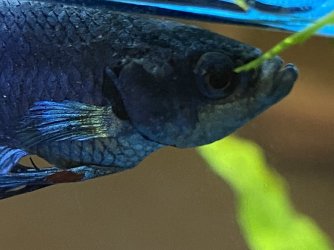
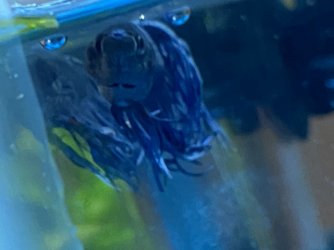
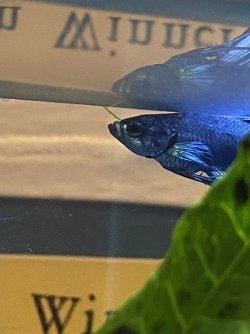
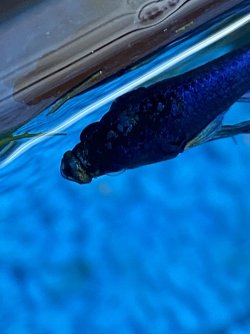

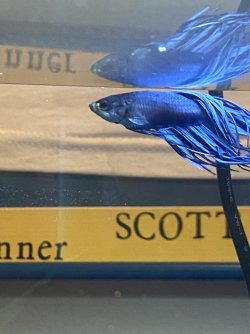
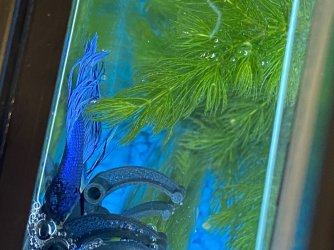
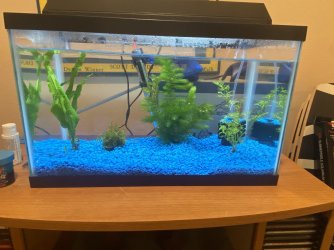
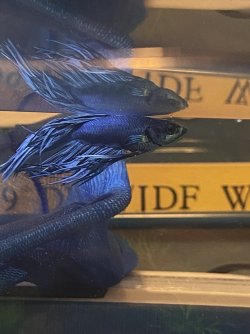
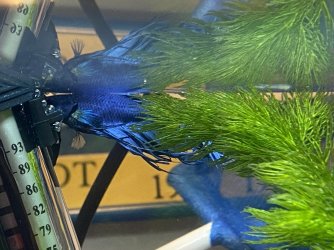
I've been very stressed about my Betta, Dobby, I received him for a white elephant gift and I'm determined to be a good fish dad! Everything is new, tank, heater, lights, plants, filter, etc. Dobby won't eat and is hanging at the top of the time and is very lethargic! Took a sample of water to get tested at my local fish store and she said everything looked good there was some nitrite but acceptable for a new uncycled tank. I have 4 different kinds of live plants and I just recently tried feeding Dobby blood worms, he didn't eat them and hasn't eaten for me since I received him on Sunday. He did just swim away from me when I took these pictures and made a noise. I don't notice any decoloration but I'm a complete noob so I don't know what to look for. I don't know what to do so anything helps, thanks in advance!
Tank size: 10 gal
Tank Age: Brand New (not cycled)
pH: Unknown
ammonia: 0
nitrite: Low
nitrate: Acceptable
kH: unknown
gH: unknown
tank temp: Heater set to 80F (the thermometer is coming it's in the mail)
Fish Symptoms (include full description including lesion, color, location, fish behavior):
Lethargic and hangs at the top of the tank all day and gasps for air, won't eat
Volume and Frequency of water changes:
Haven't changed water yet, not sure if I should or not!
Chemical Additives or Media in your tank:
I treated my water with conditioner before putting dobby in the tank waited around 30 minutes for it to do its thing
Tank inhabitants:
Just Dobby the betta with some plants
Recent additions to your tank (living or decoration):
Recently put in the plants and Dobby
Pictures:











